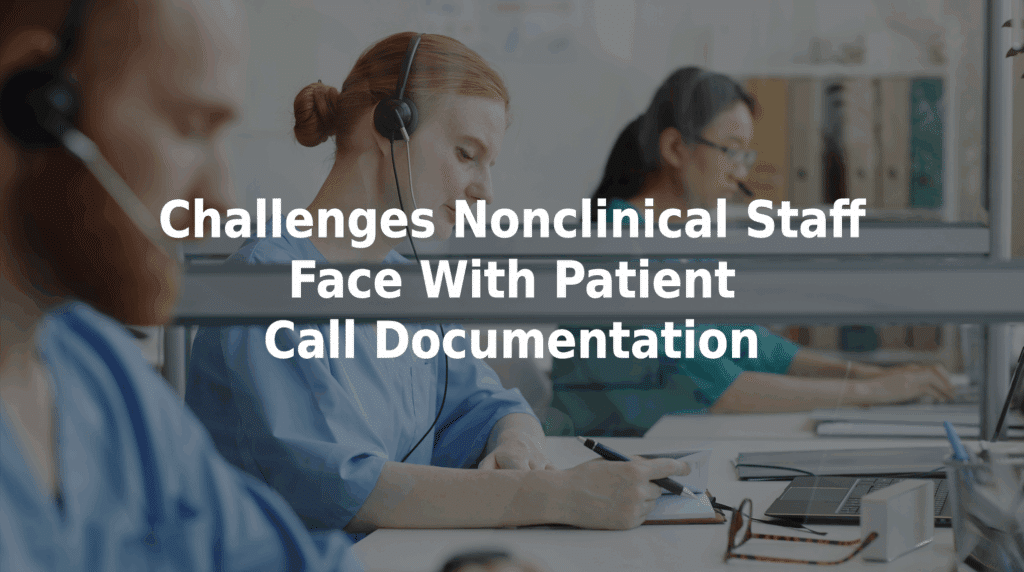Challenges Nonclinical Staff Face With Patient Call Documentation
When patient calls come into a medical practice or hospital, nonclinical staff are often the first points of contact. These operators are responsible for gathering essential information and documenting messages for clinical teams, including triage nurses. However, this process can also be problematic, particularly when it comes to accuracy. The challenges nonclinical staff face with patient call documentation can lead to delayed care, miscommunication, and even clinical errors — all of which put patients and providers at risk.
Why Patient Message Accuracy Is So Critical
Patient message intake is a vital step in the care continuum. If information is incomplete, vague, or misrouted, it delays provider responses and can lead to misdiagnoses. That’s why medical organizations must equip nonclinical staff with the tools and training they need to document messages accurately and efficiently.
Common Documentation Challenges for Nonclinical Staff
1. Lack of Medical Training
Nonclinical staff aren’t equipped to recognize red flags in patient symptoms. If a patient mentions vague discomfort or uses non-medical language, operators may not realize the urgency, ask follow-up questions, or escalate the call appropriately.
2. Recording Errors
When messages are recorded in open-ended formats (free-text versus drop-down menu options), operators may omit key details, mistype information, or misinterpret what the patient says. This leads to errors in documentation that are difficult for clinical staff to catch until it’s too late.
3. Inconsistent Messaging Protocols
Without a standardized intake structure, documentation varies by operator. This inconsistency creates gaps that affect how messages are prioritized or followed up.
4. Time Pressure and High Call Volume
Busy shifts force operators to handle calls quickly. That often results in rushed notes or skipping critical follow-up questions — especially in practices without clear intake workflows or decision support.
5. Delayed Escalations
Operators may not know when a symptom requires urgent attention. If messages are interpreted by triage nurses as routine when they should be prioritized, patients may experience harmful delays in care.
Real-World Impact: Jane Doe’s Missed Stroke Symptoms
Take the example of “Jane Doe,” a 72-year-old woman who called her doctor’s answering service one Saturday evening. She said she needed a refill for her vertigo medication. The message was categorized as “nonurgent.”
Luckily, a nurse manager also reviewed the message. She called Jane back and asked a few additional questions. Jane mentioned a bad headache, dizziness, and weakness in her right arm — classic signs of a stroke. The manager told her to hang up and call 911 immediately.
This example illustrates the critical importance of asking the right follow-up questions — something that can’t always be expected from nonclinical staff unless they’re guided by a structured system.
Best Practices to Address These Challenges
- Use Structured Intake Templates
Require operators to complete all fields using dropdowns and prompts instead of free-text fields. - Incorporate AI-Driven Question Guidance
Smart system can prompt operators with condition-specific questions to ensure critical symptoms are not overlooked. - Implement Real-Time Quality Checks
Automatically flag incomplete messages or those missing key data for review before escalation. - Offer Scenario-Based Training
Train nonclinical staff using real patient scenarios to build familiarity with symptom patterns and escalation paths. - Centralize Communication Platforms
A single system for message documentation, review, and escalation improves workflow and reduces error rates.
TriageLogic’s MedMessage Automate Can Help
TriageLogic’s MedMessage Automate is a powerful AI-supported tool that allows patients to interact through chat and structured prompts to submit complete and accurate messages — no phone calls required. This saves time, reduces staff pressure, and improves documentation quality.
Explore the Future of Patient Call Documentation
If your team is struggling with inconsistent or error-prone patient messages, it’s time to modernize your intake process. Contact us today to learn more about a program!

